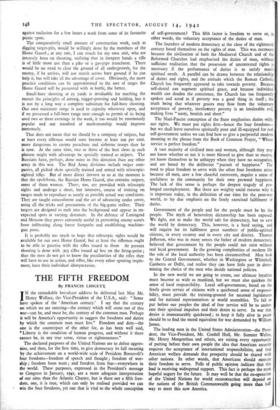HOME GUARD SHOOTING
By A H.G. MUSKETRY INSTRUCTOR In our densely populated country, shooting with ball ammunition must be subject to all sorts of safety regulations, and really safe sites for proper military ranges are not plentiful, especially in the immediate neighbourhood of towns. Most Home Guard units there- fore have to go some distance to a range, taking the best part of a day to fire some ten. rounds. And since men in civilian jobs can seldom find the time except at week-ends, the available ranges arc always crowded on Saturdays and Sundays. In such circumstances few men have a chance of firing a full-bore rifle more than four or five times in twelve months, and when they do get down to the range they are necessarily limited to an elementary standardised practice, consisting of deliberate shooting at a fixed and stationary target at 200 yards. A good battle-shot should have all the qualities and technique of a big-game shot, being trained to shoot quickly and accurately at moving and disappearing targets in all sorts of positions and from different types of cover. It is impossible to hold such practices on a crowded range.
However, a full military range with its more or less elaborate equipment is not absolutely necessary. The sort of training that would be quite adequate for the Home Guard could be given on a makeshift range of 200 yards or even less. All that is required is a clear space backed by high ground to act as a stop butt, with no buildings or public highways in the immediate danger-zone. Such spots do exist in the open spaces around London. Of course, the public would have to be denied access to the area when shooting was in progress, but it would be a poor compliment to the patriotism of the civilian population to suppose that it would make an outcry
against exclusion for a few hours a week from some of its favourite picnic spots.
The comparatively small amount of construction work, such as digging target-pits, would be willingly done by the members of the Home Guard ; at any rate, I can vouch for my own unit, who are intensely keen on shooting, realising that in inexpert hands a rifle is of little more use than a pike or a gas-pipe truncheon. There would be no need to clear the ground of all undergrowth, for the enemy, if he arrives, will not march across bare ground if he can help it, but will take all the advantage of cover. Obviously, the more practice conditions can be approximated to the sort of target the Home Guard will be presented with in battle, the better.
Small-bore shooting at 25 yards is invaluable for teaching the recruit the principles of aiming, trigger-pressing and holding, but it is not by a long way a complete substitute for full-bore shooting. Our own miniature range is used to capacity whenever open, and if we possessed a full-bore range near enough to permit of its being used two or three evenings in the week, it too would be enormously popular and our standard of marksmanship would improve immensely.
That does not mean that we should be a company of snipers, but at least every rifleman would soon become at least too per cent. more dangerous . to enemy parachute and airborne troops than he is now. At the same time, two or three of the best shots in each platoon might with advantage be specially trained as snipers. The Russians have, perhaps, done more in this direction than any other army in this war. The Red Army divisions include sniper com- panies, all picked shots specially trained and armed with telescopic- sighted rifles. But of more direct interest to us at the moment is that the opolchenie, the Russian Home Guard, also contains snipers, some of them women. These, too, are provided with telescopic sights and undergo a short, but intensive, course of training on ranges made to reproduce as nearly as possible actual war conditions. They are taught concealment and the art of advancing under cover, using all the tricks and precautions of the big-game stalker. Their targets are designed to melt into the background and appear in un- expected spots at varying distances. In the defence of Leningrad and Moscow they prove extremely useful in preventing enemy scouts from infiltrating along forest footpaths and establishing machine- gun posts.
It is probably too much to hope that telescopic sights would be available for our own Home Guard, but at least the riflemen ought to be able to practise with the rifles issued to them. At present shooting is done with .303 rifles issued ad hoc on the firing-point ; thus the men do not get to know the peculiarities of the rifles they will have to use in action, and rifles, like every other sporting imple- ment, have their individual idiosyncrasies.























 Previous page
Previous page